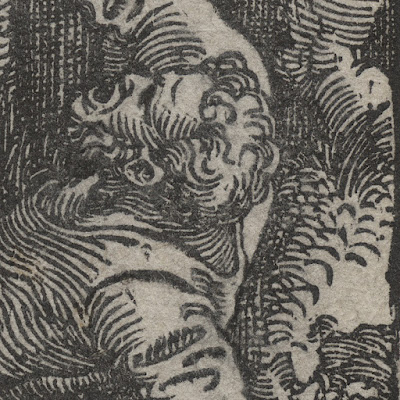Philips Galle (aka Philippe
Galle; Philippus Gallaeus) (1537–1612)
“The Slaughter of the Fattened Calf",
1562, plate 5 from the series of six numbered engravings, “The Parable of the
Prodigal Son”, after Maarten van Heemskerck (1498–1574), published by Hieronymus
Cock (aka Jérome Cock) (c1510–1570) in Antwerp.
Engraving printed with a warm black ink
on fine laid paper trimmed with narrow margins around the image borderline and
below the text lines and backed with a support sheet.
Size: (sheet) 21 x 25.4 cm; (image
borderline) 19.7 x 25 cm.
Inscribed on plate within the image
borderline: (lower left) “H Cock excu 5”.
Lettered on plate below the image
borderline: (centre) "Pater illum ... sunt"; (right) "MHemskerck
inuen- / P. galle fe."
State: ii (of iv) before the change of
publisher from Hieronymus Cock to Theodoor Galle (see the BM copy of a state
iii impression BM no. 1955,1008.15).
TIB 5601.031:5 (Walter L Strauss &
Arno Dolders [eds.] 1987, “The Illustrated Bartsch: Netherlandish Artists:
Philips Galle”, vol. 56, Supplement, New York, Abaris Books, p. 118, cat. no.
.031:5); New Hollstein Dutch 156-2(4) (Galle) (Manfred Sellink [comp. &
ed.] 2001, “The New Hollstein: Dutch and Flemish etchings, engravings and
woodcuts 1450–1700: Philips Galle”, Part 2, Rotterdam, Sound and Vision, p. 28,
cat. 152–157); New Hollstein Dutch 364 (Heemskerck) (Ilja M Veldman 1993–94,
“The New Hollstein: Dutch and Flemish etchings, engravings and woodcuts
1450-1700: Maarten van Heemskerck”, Roosendaal, Koninklijke Van Poll, cat.
360–365); Riggs 1977 126 (Timothy Riggs 1977, “Hieronymus Cock, Printmaker and
Publisher”, New York, Garland Press, 1977).
See also Barbara Haeger’s journal article, “Philips Galle's engravings
after Maarten van Heemskerck's ‘Parable of the Prodigal Son’" in “Oud
Holland”, vol. 102, no. 2, pp. 127–140: https://www.jstor.org/stable/42717512?seq=1#page_scan_tab_contents
The Rijksmuseum offers the following
description of this print:
(transl.) “In honor of the return of the
prodigal son, a fattened calf is slaughtered. The prodigal son dances with the
guests in the courtyard. A long table is ready for the banquet.”
See also the description offered by the British
Museum
Condition: richly inked and near
faultless lifetime impression in excellent condition (i.e. there are no tears,
holes, folds, stains or foxing). The sheet is trimmed near the image borderline
with the text line retained and is laid onto a support of conservator’s fine
archival/millennium quality washi paper.
I am selling this superb lifetime
impression of this rare engraving, executed only 21 years after Michelangelo
completed his fresco, “The Last Judgement” and 93 years before Rembrandt
executed his famous oil painting, “The Slaughtered Ox” (1655)—perhaps this
print even inspired Rembrandt!—for the total cost of AU$272 (currently
US$180.53/EUR160.58/GBP139.47 at the time of this listing) including postage
and handling to anywhere in the world (but not, of course, any import
duties/taxes imposed by some countries).
If you are interested in purchasing this
fascinating print illustrating the verses from Luke 15:11–32 where the son who
had squandered half of his father’s estate returned in shame only to be
received by his father with the excited exclamation: “Quick! Bring the best
robe and put it on him. Put a ring on his finger and sandals on his feet. Bring
the fattened calf and kill it. Let’s have a feast and celebrate. For this son
of mine was dead and is alive again; he was lost and is found.” (NIV), please
contact me (oz_jim@printsandprinciples.com) and I will send you a PayPal
invoice to make the payment easy.
This print has been sold

















































